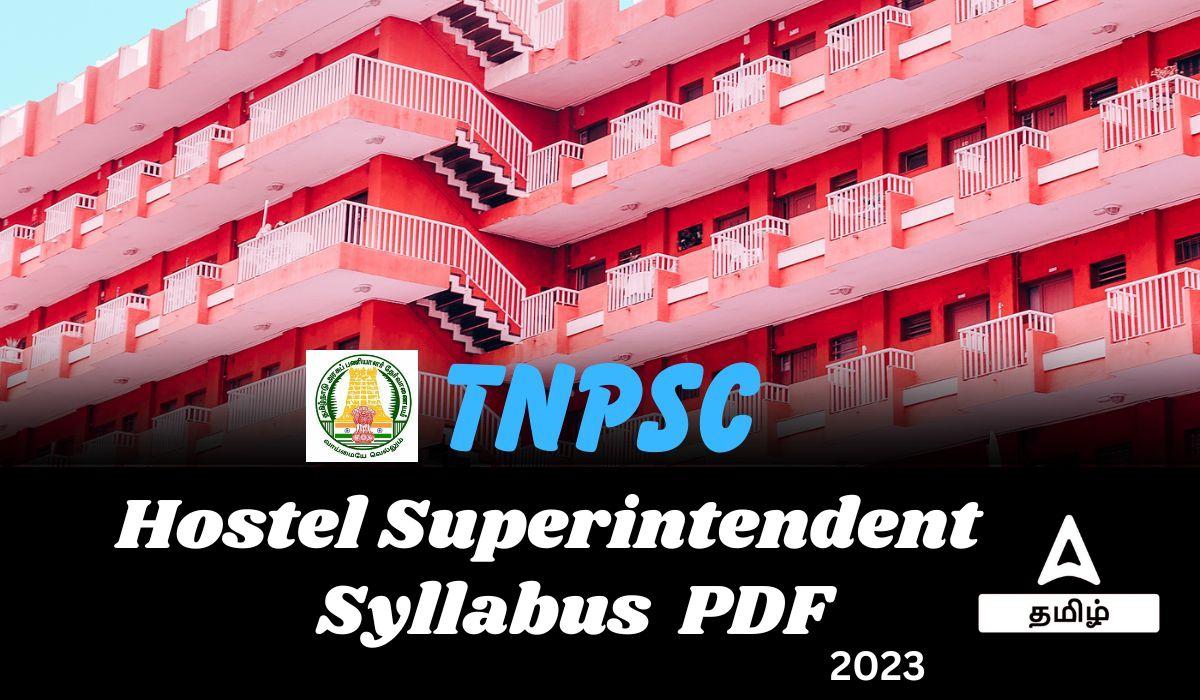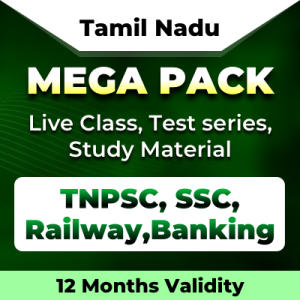Table of Contents
TNPSC விடுதி கண்காணிப்பாளர் பாடத்திட்டம் 2023: தமிழ்நாடு அரசுப் பணியாளர் தேர்வாணையம் TNPSC விடுதி கண்காணிப்பாளர் அறிவிப்பை வெளியிட்டது மற்றும் TNPSC விடுதி கண்காணிப்பாளர் தேர்வு 21 ஜனவரி 2024 அன்று நடத்தப்படும். TNPSC விடுதி கண்காணிப்பாளர் பாடத்திட்டம் 2023 மற்றும் தேர்வு முறை ஆகியவற்றைத் தயாரிப்பைத் தொடங்குவதற்கு முன் தெரிந்து கொள்வது அவசியம்.
| TNPSC விடுதி கண்காணிப்பாளர் பாடத்திட்டம் 2023 | |
| நிறுவனம் |
தமிழ்நாடு அரசு பணியாளர் தேர்வாணையம் |
| பதவி | விடுதி கண்காணிப்பாளர் (உடல் பயிற்சி அதிகாரி) |
|
காலியிடம் |
18 |
கட்டுரை வகை
|
பாடத்திட்டம் மற்றும் தேர்வு முறை |
| TNPSC விடுதி கண்காணிப்பாளர் தேர்வு தேதி 2023 | 21 ஜனவரி 2024 |
| TNPSC விடுதி கண்காணிப்பாளர் தேர்வு முறை | கணினி அடிப்படையிலானது |
|
அதிகாரப்பூர்வ இணையதளம் |
https://www.tnpsc.gov.in/ |
TNPSC விடுதி கண்காணிப்பாளர் பாடத்திட்டம் 2023
ANNEXURE-III
SYLLABUS
PAPER-I
PHYSICAL EDUCATION (DIPLOMA STANDARD)
| PHYSICAL EDUCATION (DIPLOMA STANDARD) | |
| UNIT-I | PRINCIPLES AND HISTORY OF PHYSICAL EDUCATION Meaning of Physical Education, Physical Culture, Physical Training. Aim and Objectives of Physical Education. Physical Education in Ancient Greece – Sparta and Athens – Ancient and Modern Olympic Games – Asian Games. Physical Education in India – SAI, SDAT, School Level Competitions in Tamil Nadu. School games federation of India. |
| UNIT-II | BIOLOGICAL FOUNDATIONS AND TRAINING METHODS Biological foundation: Growth and Development – Heredity and Environment, Muscle tone, Athletic heart – Reciprocal innervations – Vital capacity – Chronological age –Physiological age – mental age. Types of Muscular Contractions. Periodisation in Training. Training Load and Components of Training Load Training methods: Types of Training – Weight training – Circuit training – Fartlek Training -Interval Training. |
| UNIT-III | TESTS, MEASUREMENT, AND EVALUATION Meaning of the terms: Test, Measurement, and Evaluation. Criteria for Evaluation: Validity, Reliability, Objectivity. JCR Motor Fitness test, Muscular Fitness : Kraus Weber Minimum Muscular Fitness Test, Newton Motor Ability Test, Cardio vascular test: Harvard step test, 12 minutes run/walk test. Badminton: Miller Wall Volley Test. Basketball: Johnson Basketball Test,. Hockey: Friedel Field Hockey Test,. Volleyball: Russel Lange Volleyball Test, Brady Volleyball Test. Football: MC-Donald Soccer Test. |
| UNIT-IV | ANATOMY AND PHYSIOLOGY Cell structure and properties, Tissues, Organs, Axial and appendicular Skelton. Classification of joints . Types of muscles. Blood, Composition of Blood, Blood groups, Functions of Blood. Structure and Functions of Heart, Structure and Functions of Lungs, Structure and function of Tongue, Teeth, and Ear. Central Nervous system- Brain – Spinal cord -Reflex action, Autonomous Nervous system Effects of exercise on the various systems of the body: Skeletal System, Muscular System, Circulatory System, Respiratory System. |
| UNIT-V | HEALTH EDUCATION, SPORTS INJURIES AND PHYSIOTHERAPY Meaning of Health Education – Health Services and Supervision – Nutrition and Diet, Components of Food. Infection immunity – Causes of Disease – Malaria, Small Pox, Dysentery, Mumps, Typhoid. Sports injuries – Meaning – Importance – Treatment for hock, Poisoning, Drowning, Bleeding, Fractures, Sprain, Strain, Dislocation, Fainting, Abrasion, Dog bite, First Aid Box, Cuts – Kinds of Bandage, Sun stroke- General rule for burns – Snake Bite. Physiotherapy – Definition – importance of Physiotherapy, Principles of Physiotherapy – Electro therapy – Hydro therapy –Thermo therapy, Massage – Posture – Postural Deformities. |
| UNIT-VI | SPORTS PSYCHOLOGY AND FITNESS Meaning of Sports Psychology and its importance. Motor Learning and motor performance. Basic consideration in Motor fitness: Body build, Mental aspects, Sense Perception: Vision, Kinesthesis, Tactile. Emotional effects: Tension, Anxiety, Stress. Theories of learning: Conditioned Response – Trial and Error – insightful. Theories of Play. Physical fitness, Reaction time, Movement time, Types and Components of Physical fitness. |
| UNIT-VII | YOGA Meaning and Definition of Yoga. Eight limbs of yoga: Yama – Niyama – Asana – Pranayama-Pratyahara – Dharana – Dhyana – Samadhi. International Yoga Day. Suryanamaskar. Breathing exercises and Asanas towards Promotion of Physical, Mental and Emotional Health. |
| UNIT-VIII | METHODS AND MANAGEMENT IN PHYSICAL EDUCATION Meaning and importance of methods in Physical Education- factors influencing methods. Presentation Techniques – Class Management – Teaching aids – various methods of Teaching – Types of Tournaments , Preparation of Fixtures for Knock out, League and Combination Tournaments. Intramurals and Extramural. Different levels of Organization schools, Colleges and Universities – Guiding principles of organization – Records and Registers – Construction and maintenance of Swimming pool and Gymnasium. |
| UNIT-IX | RULES OF GAMES AND SPORTS Ground making maintenance, Equipments, Duties of Officials and Rule of sports and games: Basketball, Ball Badminton, Badminton, Cricket, Football, Handball, Hockey, Kabaddi, Kho-Kho, Tennis, Table Tennis, Volleyball. |
| UNIT-X | TRACK AND FIELD Layout of standard track (400 meters), Method of calculating Staggers and Arch start. Relay zone marking for 4*100 and 4*400. Layout of Circle/Runway and sector for : Javelin, Shot-put, Discuss, Hammer throw , Long Jump, Triple Jump and High Jump. Measurements of Standard Athletic Equipments. |
PAPER -II
Part-A
கட்டாய தமிழ்மொழி தகுதித் தேர்விற்கான பாடத் திட்டம்
(கொள்குறி வினாவிற்கான தலைப்புகள்)
பத்தாம் வகுப்பு தரம்
- பிரித்தெழுதுதல் / சேர்த்தெழுதுதல்.
- எதிர்ச்சொல்லை எடுத்தெழுதுதல்.
- பொருந்தாச் சொல்லைக் கண்டறிதல்.
- பிழைதிருத்தம் (i) சந்திப்பிழையை நீக்குதல் (ii) மரபுப்பிழைகள், வழுவுச் சொற்களை நீக்குதல் /பிறமொழிச் சொற்களை நீக்குதல்.
- ஆங்கிலச் சொல்லுக்கு நேரான தமிழ்ச் சொல்லை அறிதல்
- ஒலி மற்றும் பொருள் வேறுபாடறிந்து சரியான பொருளையறிதல்.
- ஒரு பொருள் தரும் பல சொற்கள்.
- வேர்ச்சொல்லைத் தேர்வு செய்தல்.
- வேர்ச்சொல்லைக் கொடுத்து / தொழிற்பெயரை / உருவாக்கல். வினைமுற்று, வினையெச்சம், வினையாலணையும் பெயர்,
- அகரவரிசைப்படி சொற்களை சீர் செய்தல்.
- சொற்களை ஒழுங்குப்படுத்தி சொற்றொடராக்குதல்
- இரு வினைகளின் பொருள் வேறுபாடு அறிதல்.(எ.கா.) குவிந்து-குவித்து
- விடைக்கேற்ற வினாவைத் தேர்ந்தெடுத்தல்
- எவ்வகை வாக்கியம் எனக் கண்டெழுதுதல் – தன்வினை, பிறவினை, செய்வினை, செயப்பாட்டு வினை வாக்கியங்களைக் கண்டெழுதுதல்.
- உவமையால் விளக்கப்பெறும் பொருத்தமான பொருளைத் தேர்ந்தெழுதுதல்
- அலுவல் சார்ந்த சொற்கள் (கலைச்சொல்)
- விடை வகைகள்.
- பிறமொழிச் சொற்களுக்கு இணையான தமிழ்ச் சொற்களைக் கண்டறிதல் (எ.கா.) கோல்டு பிஸ்கட் – தங்கக்கட்டி.
- ஊர்ப் பெயர்களின் மரூஉவை எழுதுக (எ.கா.) தஞ்சாவூர் – தஞ்சை
- நிறுத்தற்குறிகளை அறிதல்.
- பேச்சுவழக்கு, எழுத்துவழக்கு (வாரான் – வருகிறான்).
- சொற்களை இணைத்து புதிய சொல் உருவாக்கல்
- பொருத்தமான காலம் அமைத்தல்(இறந்தகாலம், நிகழ்காலம், எதிர்காலம்).
- சரியான வினாச்சொல்லைத் தேர்ந்தெடு.
- சரியான இணைப்புச் சொல்(எனவே, ஏனெனில், ஆகையால், அதனால், அதுபோல).
- அடைப்புக்குள் உள்ள சொல்லைத் தகுந்த இடத்தில் சேர்க்க.
- இருபொருள் தருக.
- குறில் – நெடில் மாற்றம், பொருள் வேறுபாடு.
- கூற்று, காரணம் – சரியா? தவறா?
- கலைச் சொற்களை அறிதல் :-எ.கா. – Artificial Intelligence – செயற்கைநுண்ணறிவு Super Computer – மீத்திறன் கணினி
- பொருத்தமான பொருளைத் தெரிவு செய்தல்
- சொற்களின் கூட்டுப் பெயர்கள் (எ.கா.) புல் –புற்கள்
- சரியான தொடரைத் தேர்ந்தெடுத்தல்
- பிழைதிருத்துதல் (ஒரு-ஓர்)
- சொல் – பொருள் – பொருத்துக
- ஒருமை-பன்மைபிழை
- பத்தியிலிருந்து வினாவிற்கான சரியான விடையைத் தேர்ந்தெடு.
Part-B
GENERAL STUDIES (SSLC Standard)
(Topics for Objective Type)
| GENERAL STUDIES (DEGREE STANDARD) | |
| UNIT-I: GENERAL SCIENCE | i. Nature of Universe – Measurement of Physical Quantities – General Scientific Laws in Motion – Force, Pressure and Energy – Everyday application of the basic principles of Mechanics, Electricity, Magnetism, Light, Sound, Heat and Nuclear Physics in our daily life. ii. Elements and Compounds, Acids, Bases, Salts, Petroleum Products, Fertilizers, Pesticides, Metallurgy and Food Adulterants. iii. Main concepts of Life Science, Classification of living organisms, Evolution, Genetics, Physiology, Nutrition, Health and Hygiene, Human diseases. iv. Environmental Science. |
| UNIT-II: CURRENT EVENTS | i. Latest diary of events – National symbols – Profile of states –Eminent personalities and places in news – Sports – Books and Authors. ii. Welfare Scheme of Government – Political parties and Political system in Tamil Nadu and India. iii. Latest inventions in Science and Technology – Geographical Land Marks –Current Socio – Economic issues. |
| UNIT-III: GEOGRAPHY | i. Earth Location – Physical Features – Monsoon, rainfall, weather and climate–Water resources–Rivers –Soil, Minerals and Natural resources– Forest and Wildlife–Agriculture pattern. ii. Transport– Communication. iii. Population density and distribution in Tamil Nadu and India. iv. Calamities – Disaster Management – Environment – Climate change. |
| UNIT–IV: HISTORY AND CULTURE OF INDIA | i. Indus Valley Civilization – Guptas, Delhi Sultans, Mughals and Marathas –South Indian History. ii. Characteristics of Indian Culture, Unity in Diversity – Race, Language, Custom. iii. India as a Secular State. |
| UNIT-V: INDIAN POLITY | (i) Constitution of India-Preamble to the Constitution- Salient features of the Constitution- Union, State and Union Territory. (ii) Citizenship, Fundamental Rights, Fundamental Duties, Directive Principles of State Policy. (iii) Union Executive, Union Legislature – State Executive, State Legislature – Local Governments, Panchayat Raj. (iv) Spirit of Federalism: Centre-State Relationships. (v) Election – Judiciary in India – Rule of Law. (vi) Corruption in Public Life– Anti-corruption measures – Lokpal and LokAyukta – Right to Information- Empowerment of Women-Consumer Protection Forums, Human Rights Charter. |
| UNIT-VI: INDIAN ECONOMY | (i) Nature of Indian Economy –Five year plan models-an assessment –Planning Commission and NitiAyog. (ii) Sources of revenue – Reserve Bank of India – Fiscal Policy and Monetary Policy – Finance Commission–Resource sharing between Union and State Governments – Goods and Services Tax. (iii) Structure of Indian Economy and Employment Generation, Land Reforms and Agriculture-Application of Science and Technology in Agriculture-Industrial growth-Rural Welfare Oriented Programmes – Social Problems – Population, Education, Health, Employment, Poverty. |
| UNIT-VII: INDIAN NATIONAL MOVEMENT | National Renaissance –Early uprising against British Rule–Indian National Congress – Emergence of Leaders –B.R.Ambedkar, Bhagat Singh, Bharathiar, V.O.Chidambaranar, Thanthai Periyar, Jawaharlal Nehru, Rabindranath Tagore, Kamarajar, Mahatma Gandhi, Maulana Abul Kalam Azad, Rajaji, Subhash Chandra Bose, Muthulaksmi Ammaiyar, Muvalur Ramamirtham and other National Leaders. ii. Different modes of Agitation of Tamil Nadu and movements. |
| UNIT-VIII: History, Culture, Heritage and Socio-Political Movements in Tamil Nadu |
(i)History of Tamil Society, related Archaeological Discoveries, Tamil Literature from Sangam age till contemporary times (ii) Thirukkural : (a) Significance as a Secular Literature (b) Relevance to Everyday Life (c) Impact of Thirukkural on Humanity (d) Thirukkural and Universal Values – Equality, Humanism, etc (e) Relevance to Socio-Politico-Economic affairs (f) Philosophical content in Thirukkural iii. Role of Tamil Nadu in freedom struggle – Early agitations against against British Rule – Role of women in freedom struggle. iv.Various Social reformers, Social reform movements and Social transformation of Tamil Nadu. |
| UNIT–IX: Development Administration in Tamil Nadu | i. Social Justice and Social Harmony as the Cornerstones of Socio-Economic Development. ii. Education and Health systems in Tamil Nadu. iii. Geography of Tamil Nadu and its impact on Economic growth. |
| UNIT-X: APTITUDE AND MENTAL ABILITY | i. Simplification – Percentage – Highest Common Factor (HCF) – Lowest Common Multiple (LCM). ii. Ratio and Proportion. iii. Simple Interest– Compound Interest – Area – Volume – Time and Work. iv. Logical Reasoning – Puzzles – Dice – Visual Reasoning – Alpha Numeric Reasoning – Number Series. |
TNPSC விடுதி கண்காணிப்பாளர் பாடத்திட்டம் 2023 PDF
TNPSC விடுதி கண்காணிப்பாளர் 2023 பாடத்திட்டத்தில் மேலே குறிப்பிடப்பட்ட தலைப்புகள் தொடர்பான கேள்விகள் இருக்கும். விண்ணப்பதாரர்கள் பாடத்திட்டத்தை முழுமையாக படித்து அதற்கேற்ப தயார் செய்து தேர்வில் நல்ல மதிப்பெண் பெற அறிவுறுத்தப்படுகிறார்கள். TNPSC விடுதி கண்காணிப்பாளர் பாடத்திட்டத்தை PDFஇல் பதிவிறக்கம் செய்ய கீழே உள்ள இணைப்பை கிளிக் செய்யவும்.
TNPSC விடுதி கண்காணிப்பாளர் பாடத்திட்டம் 2023 PDF
TNPSC விடுதி கண்காணிப்பாளர் தேர்வு முறை
| TNPSC விடுதி கண்காணிப்பாளர் தேர்வு முறை | ||||
| Subject (CBT Method) | Duration | Maximum marks | Minimum qualifying marks for selection | |
| SCs, SC(A)s, STs, MBCs/DCs BC(OBCM)s & BCMs | Others | |||
| i. Paper –I (Subject Paper) (Diploma Standard) (200 Questions) Physical Education(Code No. 354) |
3 Hours | 300 | 135 | 180 |
| ii. Paper – II (Objective Type) Part-A Tamil Eligibility Test (SSLC Std) (100 questions/150 marks) |
3 Hours | 150
Note: Minimum qualifying marks – 60 marks (40% of 150)Marks secured in Part-A of Paper-II will not be taken into account for ranking. |
||
| Part-B (General Studies) (100 questions) (150 marks) (Code No:003) General studies (SSLC standard) – 75 questions and Aptitude and mental ability test (SSLC standard) – 25 questions |
150 | |||
| Total | 450 | |||
**************************************************************************
| Adda247 TamilNadu Home page | Click here |
| Official Website=Adda247 | Click here |
Adda247App | Adda247 Tamil Youtube
Adda247 Tamil telegram group –Tnpsc sure shot selection group
Instagram = Adda247 Tamil
TNPSC விடுதி கண்காணிப்பாளர் பாடத்திட்டத்தை அதிகாரப்பூர்வ இணையதளத்தில் வெளியிட்டுள்ளது. TNPSC விடுதி கண்காணிப்பாளர் பாடத்திட்டம் PDF & தேர்வு முறையை இங்கே பதிவிறக்கம் செய்யலாம்.








